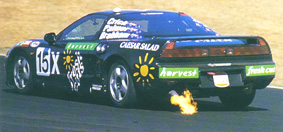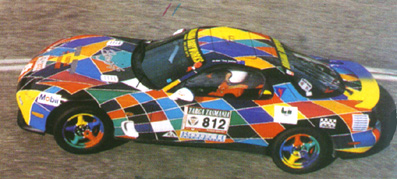At Eastern Creek with Mazda's carbon fibre winged RX-7 SP road registered street and race cars.
There's a saying in sport that only winners are remembered-no-one
takes
notice of who comes second. But when John Nowe crossed the Eastern
Creek
start/finish line for the 409th time in a little over 12 hours and two
minutes, it not only enforced Mazda's dominance of the fifth annual 12
hour endurance event, it hammered down for the third successive year
Mazda
Motorsport Australia's superiority over its main rivals Porsche. For
the
1995 12 hour, two major changes were obvious: theswitch from Mt
Panorama
to Eastern Creek; and the addition of limited-production homologation
models-BMW's
M3-R pulled out of the race several weeks befor it even started due to
suspected lack of speed :) ;Volvo had its T5-Rs with its high-profile
driver
pairings, Mazda it's reworked and highly successful RX-7 to SP
specifiations,
while Porsche replaced it's underpowered four-cylinder 968 CS dog with
the (bearly) road-registerable race car, the 3.8-litre 911 RS CS.
Winning
the GT-Production championship in the hands of Jim Richards, Porsche
had
possibly its best (only :) ) chance at turning the tables and beating
the
Mazda Motorsport team. Everything was looking good at the 12 Hour-
Porsches
set the fastest times throughout practice and like Mazda in '94, was
sitting
on the first three positions of the grid-it was looking like the German
manufacturer finaly had the edge on the Mazdas.
But history shows it wasn't to be (HA ha). Allan Horsley and hie
Tripple
M Mazda Motorsport team master-minded the victory in an event which has
become Mazda's biggest triumph and Porsche's greatest frustration. In
three
attempts, Porsche has crossed the finish line behind an RX-7. Maybe
next
year's entry should be called the Porsche 911 Bridesmaid…
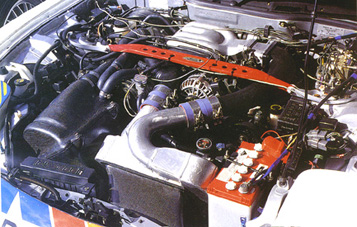 .............
.............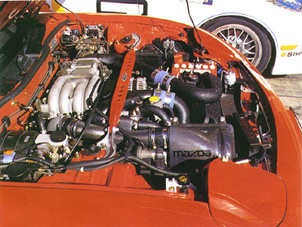
But what actually goes into a 12 Hour champion? And what makes
an SP?
At the venue of its victory, Garry Waldon, the winning number
seven Triple M RX-7 SP and a red road going SP made their way to
Eastern Creek for evaluation.
Since its introduction in 1992, the series 6 RX-7 proved a highly
competitive
car not only here in Australia, but in the USA and throughout the
world.
Since the elimination of the rotary in Group A racing in 1984,
Mazda
Australia had only production car racing to expose its 13B turbo
rotary-engined
cars to the racetracks of Australia. The twin-turbo RX-7 made its
12 Hour debut in 1992 in the hands of Charlie O'Brien, Mark Gibbs and
the
late Gregg Hansford, who drove it to victory.
In 1995, the RX-7 SP was born. Something impressive about the RX-7
SP is how quickly and efficiently it was developed - local development
and production of the parts obviously helped. With the introduction of
1995's new regulations, according to Mazda's PR Steve Rowland 'in
February
the SP was still an idea in Allan's (Horsley's) head'. Three months and
apparently less than $ 10,000 in total development costs later, Horsley
and head spanner Daniel Deckers rolled the RX-7 SP out of its
Kingsgrove
workshop - a potential GT-P and 12 Hour winner.
The list of exact changes made to convert a standard Australian-spec twin-turbo RX-7 to 'SP' specs numbers 60. Most notable is the front nose cone which has a greatly increased air intake (necessitating the extra strength of the carbon fibre) and rear spoiler; both made from carbon fibre, they produce noticeably more downforce with the obvious lighter-than-plastic weight advantage. 'We tested the rear spoiler in three different guises out here (Eastern Creek),' informed Garry Waldon: no spoiler at all, the factory spoiler and the high mount version - which won favour. 'The small standard spoiler proved it was faster around Eastern Creek than no spoiler at all but the high-mount was around six-to-seven-tenths quicker again.' The notorious Turn One sweeper is where the rear spoiler benefits most, raising the car's corner speed 5km/h 'You can really feel the increased downforce around here," added Waldon who hustled through the sweeper during the race consistently over 200 km/h.
Mazda's other trump card was its brake pad consumption. Normally the forte of the smaller and lighter cars, the Mazda SP's larger diameter and thickness rotor and larger four-spot front calipers miraculously made it through the 12 hours of punishment on one single set of Endless brake pads. According to Horsley, at the end of the race the pads were removed and "still had 'enough' meat on them". Improving the power-to-weight ratio was a prime concern with the SP. Weight was further reduced with a pair of Recaro's SP-A seats weighing in at 2.5 kg each!Being essentially production cars, probably the biggest modification to the car is the fueling system which can swallow around 110 litres in less than 20 seconds. Note the gearbox and diff temp gauges, which can be monitored at a glance during pit stops, and the perspex shielding partitioning the cabin.
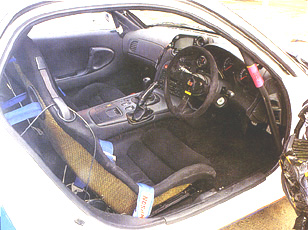 ..................
..................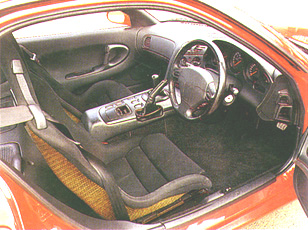
Its kilowatt output went from 176kW for the standard RX-7, to 204kW
for the SP, and around 240kW for the race car. The big additions came
from
the exhaust system and the three times more efficient than standard
air-to-air
intercooler - turbo modification extended to only minor seal changes.
The
road car puts out a whopping 357Nm of torque (versus the standard car's
294) and it's immediately noticeable on the road. The days of rotaries
having no torque are long gone - fifth gear at 60km/h pulls similarly
to
an average family sedan in second.
To take full advantage of the improved power output, the diff ratio
was changed from a 4.1 to a 4.3 aiding acceleration while still
stretching
the car's top speed I 0 km/h beyond the standard car to 260 km/h.
Power windows and mirrors, electrically-operated sunroof, cruise
control,
CD player, ABS, driver's side airbag and optional air
conditioning.
All things, Mazda proudly proclaims, the Porsche 91 1 RS CS is missing
and all things (apart from the air-bag and A/C) were taken along for
the
12 hour ride. The Porsches also miss out on a rear seat, carpet and
hoodlining,
although at 1270kg, it would need to. The RX-7 SP tips the scales at
1218kg,
another 92kg lighter than the standard model.
Wheel size on the SP has been increased one-inch in diameter to 17
front and rear while the tyres have also grown to 235/45 front and
255/40
rear - not to mention the proudly-Australian kangaroo centre caps.
Sales of the 25 SPs spiked in the few days after the 12 Hour, with
all 25 being snapped up quick smart, prompting Mazda to produce another
10.
The 204 kW Mazda has proven it can match the 221 kW Porsche 91 1 RS CS on the track and priced at just over $100,000, the 35 models are arguably a much better value for money proposition in the salesroom than the 12 $220,000 Porsches which made it to Australia.
Rotaries triumph in Australia's most prestigious production car race.
Eastern Creek, 27th August 1995; Mazda's RX-7 SP shunned its critics by claiming victory in the race they said should have been Porsche's. For the first year, Porsche, Mazda and Volvo fronted their homologation specials, purpose built for production car endurance races. Allan Horsley drove the final nail into Fitzgerald's Porsche coffin by beating its highly acclaimed 911 RSCSs in his 12 Hour-unconquered RX-7s.
Mazda's qualifying and pre-race preparation was marred by an accident involving the black number nine RX-7 SP of Mark Skaife and Garry Waldon. Back up driver Allan Grice lost control of the car at more than 160km/h exiting the left-hander around Corporate Hill in practice on Saturday when he misjudged the braking point. The Mazda was badly damaged on the right hand side and had many wondering if it would front for the start at 6.OO AM Sunday morning. The Mazda Motorsport team began work on the car late Saturday afternoon topping off the repair job with sponsors' stickers less than half an hour before the start of the 12 hour enduro.The second factory RX-7 SP was badly damaged on Saturday afternoon in a practice session, when back-up driver Allan Grice lost control at more than 160km/h exiting Corporate Hill. The caramazingly lined up for the start at 6:00am with the Mazda Motorsport team working non-stop throughout the night.
Come race morning, the Fitzgerald/Richards 91 1 RSCS darted away from the line followed by the other two 91 1 s. The three RX-7s were hot on their tails, though, with the Johnson/Bowe car working its way through the field to have its first stint in the lead on lap 15. Tyres were of critical importance on the renowned Eastern Creek track. And the recent track re-surfacing ensured teams were playing somewhat of a lottery when it came to tyre choice and pit stops. The fantastic duel which had developed between the Johnson/Bowe RX-7 SP and the Fitzgerald/Richards Porsche 911 RSCS was marred by an incident involving the pace car (or Safety Car is it is now known). The situation arose when the pace car entered the track, following an instruction by the Clerk of the Course, behind the leading RX-7 of Johnson/Bowe allowing it to complete another lap at race speeds. Porsche claimed that 'under racing convention' the pace car should enter the track ahead of the leading car. Fitzgerald Racing later protested the incident due to the closeness of the finish, but Mazda's victory was later confirmed following a CAMS hearing.Alan Jones and Terry Bosnjak were entered in the third RX-7 SP. With limited technical assistance and parts from Mazda, the 'semi-works' number 8 car unfortunately retired on lap 94 with electrical problems. Befor the problems, however, the car was running strongly, at one stage leading the race for one lap on lap 48.
The Eastern Creek 12 Hour also marked the first time a Class B car (1851cc-2600cc) has beaten the leading Class A car (0- 1 850cc), Mark Brame's Swift GTI in every case.Another immaculately executed pit-stop for the race winning number 7 RX-7 SP of Dick Johnson and John Bowe. Car 7 made only 7 pit-stops and crossed the finish line (after 409 laps or 1607 km) on the same set of brake pads it started with.
